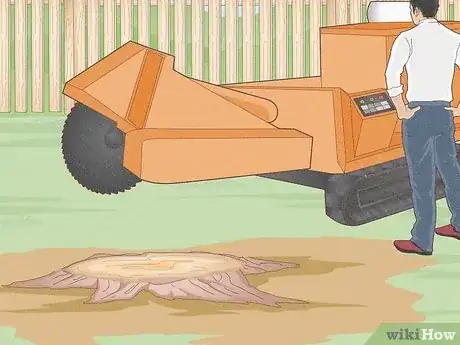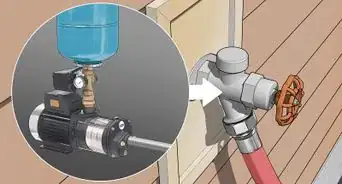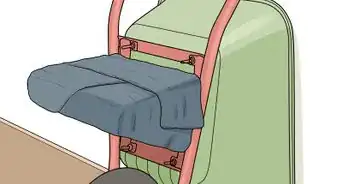This article was co-authored by Scott Johnson and by wikiHow staff writer, Jessica Gibson. Scott Johnson is the Owner and Lead Design Consultant for Concrete Creations, Inc., an award-winning landscape and design company based in the San Diego, California metro area. He has over 30 years of experience in the pool and landscape construction industry and specializes in large estate outdoor environment construction projects. His work has been featured in San Diego Home & Garden Magazine and on Pool Kings TV Show. He earned a BS degree in Construction Management with an emphasis in Architecture and CAD design from Northern Arizona University.
There are 7 references cited in this article, which can be found at the bottom of the page.
This article has been viewed 4,001 times.
If you've tried drilling, burning, or chopping a tree stump with no luck, it's probably time to reach for a stump grinder. This specialized tool features a cutting blade that shreds a stubborn stump to pieces and makes tree stump grinding easy. Although you can't make a DIY stump grinder, you can rent one. In this article, we'll walk you through setting up the stump grinder and give you helpful tips for safely operating the machine.
Steps
Getting Ready to Grind
-
1Rent a stump grinder from a local hardware store. It'll usually cost around $100 to $150 to rent a stump grinder for several hours. Since the machines weigh around 1,000 pounds (450 kg), you'll need to have a reliable way to haul the grinder home.[1]
- If you have neighbors who also want to remove tree stumps from their yards, you might talk with them about going in on the rental. This is a great way to cut costs.[2]
- Ask the salesperson to explain how to use the exact model you're renting. Most of them are happy to go over the basic operations and safety features.
-
2Put on safety glasses and hearing protection. Wear sturdy closed-toed boots and pop on gloves for extra security. The cutting blades rotate extremely fast, so personal protective equipment is really important.[3]
- Read the safety manual that came with your stump grinder to learn if there are any other safety recommendations for using the machine.
Advertisement -
3Clear kids and pets away from the space before you begin. Stump grinders can throw wood chips or objects far from the stump, so keep bystanders, kids, and pets far away—at least 75 feet (23 m).[4]
- If you're using the stump grinder around windows or cars, it's a good idea to put up protective coverings, so flying debris doesn't damage your property.
-
4Remove rocks and branches from around the stump. The teeth of the blades can become dull if they're trying to cut into rocks. Take a shovel and dig around the stump, so you can remove large objects like rocks or branches.[5]
- If you suspect there are buried utility lines below the stump, contact your utility company before you begin removing the stump.
-
5Use a chainsaw to cut the stump low to the ground. You'll have a much easier time operating the machine and you'll cut out some of the time it takes if you cut the stump as low to the ground as possible.[6]
- If you don't have a chainsaw, use an ax to cut the stump.
- Besides this, there are several ways in which you can get rid of a tree stump. You can burn it. [7]
- Drill holes at a distance of three inches around the stump. Then pour a root killer into the holes.[8]
- You can excavate the root. But that can be expensive.[9]
Using the Stump Grinder Safely
-
1Position the grinder on level ground so the grinding wheel faces the stump. If the ground is slightly sloped, point the grinder uphill, so you won't lose control of it. Always stay behind the grinder wheel—stand behind the control panel.[10]
- Avoid using a stump grinder on steep hillsides since it's harder to handle.
-
2Raise the grinder wheel over the stump and engage the clutch. Start at 1 side of the stump near the roots. Engage the clutch in low or slow mode—the cutting blades will begin to spin rapidly. Hold on tightly to the handlebars, since you might feel a kickback when you turn on the engine.[11]
- Keep a firm grip on the handle of the stump grinder—you'll feel strong vibrations once you engage the clutch.
- The controls for stump grinders vary by brand which is why it's so important to read the manufacturer's instructions before you begin. Your machine might recommend setting the handlebars at waist height for instance.
-
3Lower the cutting blade into the stump and sweep it from side to side. Let the grinding blade sink a few inches into the stump.[12] Then, slowly swing the blade a few inches to the right and then to the left without lifting the blades back up. Don't grind away more than 3 inches (7.6 cm) at a time. Keep grinding until you've worked across the entire surface of the stump.
- Take your time and don't force the grinder to go deep below the surface.
- Don't try to push the grinder forward while you're sweeping from side to side, or you could damage the machine or grinding blade.
-
4Grind the stump until the grinding blade is 6 to 8 in (15 to 20 cm) below the surface. This might seem pretty deep, but you want to ensure that you're getting all the roots. Lower the throttle, turn off the machine, and wheel it away from the area.[13]
- If you're working in a bumpy area, you might have to accelerate the engine throttle, so you can grind through tough roots.
-
5Fill the hole with wood chips or soil. You'll have a lot of wood chips and shavings from the stump, so feel free to fill in the hole with them. They'll decompose over time. You can also fill the hole with topsoil or soil from your yard. If you're going to grow grass over the site, scatter grass seed and water the area thoroughly.[14]
- As the wood materials decompose, the ground will sink, so you may need to add soil throughout the year.
Warnings
- Shut down the engine immediately if the grinder starts making a strange noise or vibration. Wait 5 minutes before you inspect the machine for damage.[15]⧼thumbs_response⧽
Things You’ll Need
- Gloves
- Eye and ear protection
- Closed-toed shoes
- Stump grinder
- Chainsaw or ax
- Rake or shovel
References
- ↑ https://www.thisoldhouse.com/landscaping/21016019/how-to-remove-tree-stumps
- ↑ https://www.popularmechanics.com/home/lawn-garden/how-to/a129/stump-grinder-tips/
- ↑ https://weedcut.ipm.ucanr.edu/management-practices/stump-grinding/#gsc.tab=0
- ↑ https://tcimag.tcia.org/tree-care/operating-the-stump-grinder/
- ↑ https://www.thisoldhouse.com/landscaping/21016019/how-to-remove-tree-stumps
- ↑ https://weedcut.ipm.ucanr.edu/management-practices/stump-grinding/#gsc.tab=0
- ↑ https://www.treetriage.com/stump-removal/burn-tree-stumps/
- ↑ https://www.rhs.org.uk/plants/types/trees/stump-removal
- ↑ https://www.rhs.org.uk/plants/types/trees/stump-removal
- ↑ https://tcimag.tcia.org/tree-care/operating-the-stump-grinder/
- ↑ https://tcimag.tcia.org/tree-care/operating-the-stump-grinder/
- ↑ https://tcimag.tcia.org/tree-care/operating-the-stump-grinder/
- ↑ https://www.thisoldhouse.com/landscaping/21016019/how-to-remove-tree-stumps
- ↑ https://www.thisoldhouse.com/landscaping/21016019/how-to-remove-tree-stumps
- ↑ https://tcimag.tcia.org/tree-care/operating-the-stump-grinder/




































































